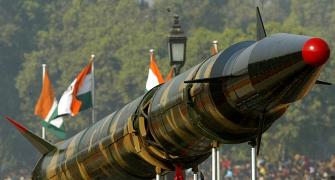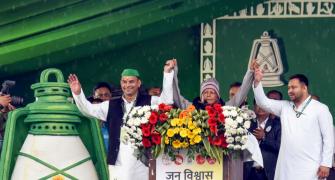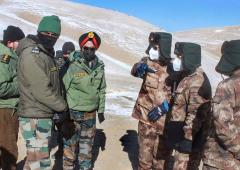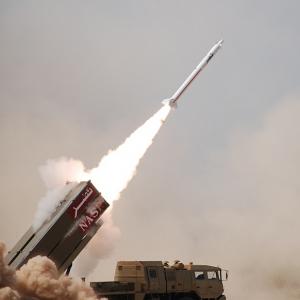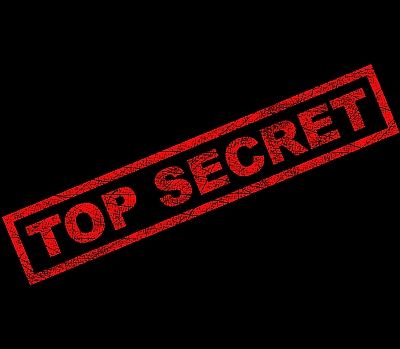 India has built two top-secret facilities in Karnataka to enrich uranium in pursuit of its hydrogen bomb dream, journalist Adrian Levy reports in Foreign Policy magazine.
India has built two top-secret facilities in Karnataka to enrich uranium in pursuit of its hydrogen bomb dream, journalist Adrian Levy reports in Foreign Policy magazine.
In early 2012, India started constructing a secret facility in rural Karnataka that villagers in the region had no clue about.
Efforts by a local panchayat member, and an NGO, to find out what was behind the excavation and the construction work that started soon after, were met with a stonewall. That the project was being driven by the Prime Minister's Office, no less.
Investigations by journalist Adrian Levy, as reported in Foreign Policy magazine, revealed that the project, in Challakere, Karnataka, was to build 'the subcontinent's largest military-run complex of nuclear centrifuges, atomic-research laboratories, and weapons- and aircraft-testing facilities when it's completed, probably some time in 2017.'
'A lengthy investigation by the Center for Public Integrity (CPI), including interviews with local residents, senior and retired Indian scientists and military officers connected to the nuclear programme, and foreign experts and intelligence analysts, has pierced some of the secrecy surrounding the new facility, parts of which are slated to open in 2016,' writes Levy.
'This new facility will give India a nuclear capability -- the ability to make many large-yield nuclear arms -- that most experts say it presently lacks,' Levy adds.
The project's stated aims, apparently, are to 'expand the government's nuclear research, to produce fuel for India's nuclear reactors, and to help power the country's fleet of new submarines.'
But, quoting 'retired Indian government officials and independent experts in London and Washington,' Levy concludes that another of the project's ambition is 'to give India an extra stockpile of enriched uranium fuel that could be used in new hydrogen bombs, also known as thermonuclear weapons, substantially increasing the explosive force of those in its existing nuclear arsenal.'
Preparation for the enrichment effort at Challakere has been under way for four years, according to Western analysts who spoke to Levy on condition of anonymity, at the Rare Materials Plant, near Mysore, another top secret site.
Functioning effectively as a test bed for Challakere, this plant was outed, in a manner of speaking, via satellite photos from 2014, as a new nuclear enrichment complex. Western analysts maintain, writes Levy, that this project serves as both a 'proving ground for technology and a place where technicians can practise producing the highly enriched uranium' needed for making hydrogen bombs.
India does not disclose information about its stockpile since going nuclear in 1974, but the independent Stockholm International Peace Research Institute estimates that it has between 90 and 110 nuclear weapons, as against Pakistan's 120 and China's 260 warheads.
While China tested a thermonuclear weapon as early as 1967, India did so only in 1998, but its yield has been questioned by experts, including the project director K Santhanam who famously described it as a 'fizzle.'
Writes Levy: 'The ministry of environment, forests, and climate change approved the Mysore site's construction in October 2012 as "a project of strategic importance" that would cost nearly $100 million, according to a letter marked 'secret,' from the ministry to atomic energy officials that month. Seen by the CPI, this letter spells out the ambition to feed new centrifuges with fuel derived from yellowcake -- milled uranium ore named after its colour -- shipped from mines in the village of Jadugoda in India's north, 1,200 miles away from the Rare Materials Plant, and to draw water from the nearby Krishna Raja Sagar dam.'
However, he says, 'spokesmen for the two organisations involved in the Challakere construction, the Defence Research and Development Organisation and the Bhabha Atomic Research Centre, which has played a leading role in nuclear weapons design, declined to answer any of CPI's questions, including about the government's ambitions for the new park.' As did the ministry of external affairs.
The secrecy surrounding the project is impenetrable and the villagers of Challakere were not the only ones would could not pierce it, even members of Parliament could make no progress.
'One veteran lawmaker, who has twice been a Cabinet minister, and who asked not to be named due to the sensitivity of the topic, said his colleagues are rarely briefed about nuclear weapons-related issues. "Frankly, we in Parliament discover little," he said, 'and what we do find out is normally from Western newspapers,' reports Levy.
However, in 2007, the local member of Parliament did manage to get then defence minister A K Antony (who refused to be interviewed by Levy) disclose plans for the park, at a time the operationalisation of the nuclear deal between India and the United States was still facing obstacles in both countries.
Reports Levy: 'By May 2009, seven months after (the US) Congress ratified the US-India nuclear cooperation deal, the Karnataka state government had secretly leased 4,290 acres adjacent to the villages of Varavu Kaval and Khudapura in the district of Chitradurga to the DRDO and another 1,500 acres to the Indian Institute of Science, a research center that has frequently worked with the DRDO and India's nuclear industry, documents obtained by lawyers showed. In December 2010, the state government leased a further 573 acres to the Indian Space Research Organisation and the BARC bought 1,810 acres.'
In 2011, some light was shed on the secret project when Srikumar Banerjee, then chairman of the Atomic Energy Commission, told a television network that the 'enrichment plant could be used to produce nuclear fuel, or slightly enriched uranium, to power India's heavy- and light-water reactors.'
However, Banerjee added that the site would also have a strategic use, a designation that would keep international inspectors away. (India's nuclear agreement with Washington and others provides no access to military-related facilities).
In 2012, when the NGO Environment Support Group filed a suit in the Karnataka high court seeking details of pasture land seized by the authority, it came to light that land had been leased not just for the enrichment project, but 10,000 acres were given to the army to station 2,500 soldiers, and another 350 acres were given to the state reserve police, and 500 acres had been set aside for a commando training centre.
In other words, Challakere was a nuclear city that would be ring-fenced by the army and paramilitary.
Independent nuclear analysts like Serena Kelleher-Vergantini, an analyst at the Institute for Science and International Security, a Washington-based non-profit, and Robert Kelley, formerly of the IAEA who was commissioned by Jane's Intelligence Review, who studied satellite imagery, were struck by the scale and ambition of the military-nuclear park which, at 20 square miles, was comparable in size to New York state's capital Albany, reports Levy.
'After analysing the images and conducting interviews with atomic officials in India, Kelleher-Vergantini concluded that the footprint for enrichment facilities planned in the new complex would enable scientists to produce industrial quantities of uranium (though the institute would only know how much when construction had progressed further).'
As Kelley examined photos of the second site, he was astonished by the presence of two recently expanded buildings that had been made lofty enough to accommodate a new generation of tall, carbon-fibre centrifuges, capable of working far faster to enrich uranium than any existing versions.'
The productiveness of enrichment machines are measured in Separative Work Units, and Kelly concluded that at the new site, 'the government could install up to 1,050 of these new hyper-efficient machines, which, together with about 700 older centrifuges, could complete 42,000 SWUs a year' -- enough, he said, to make roughly 403 pounds of weapons-grade uranium every year.
A new hydrogen bomb of 100,000 tonnes of TNT yield, requires only between nine and 15 pounds of uranium.
Asked about the extra uranium, a senior scientist at the DRDO told Levy that it would mostly be used to fuel civilian nuclear power reactors and in 'benign medical and scientific programmes.'
Retired Indian nuclear scientists and military officers said in interviews that India's growing nuclear submarine fleet would be the first beneficiary of the newly produced enriched uranium, reports Levy.
However, India's lone nuclear submarine, the INS Arihant, requires only about 143 pounds of uranium.
Using this figure and the estimated capacity of the centrifuges India is installing in Mysore alone -- not including Challakere -- Kelley concluded that even after fuelling its entire submarine fleet there would be 352 pounds of weapons-grade uranium left over every year, or enough to fuel at least 22 H-bombs, reports Levy.
A senior Obama administration official in Washington pointed out to Levy that India's civilian nuclear programme, that includes power stations and research establishments, were benefitting from the new access to imported nuclear fuel since 2007, and that they now require almost 'no homemade enriched uranium.'
Also, Levy points out, India does not have to report what it does with its indigenous uranium, 'especially if it is not in the civilian domain,' quoting Sunil Chirayath, a research assistant professor at Texas A&M University and an expert on India's civilian nuclear programme.
India, according to former Australian non-proliferation chief John Carlson, is among the only three nations that continue to produce fissile materials for nuclear weapons -- the other two are Pakistan and North Korea.
You can read Adrian Levy's full report here (subscription only).
Don't miss Adrian Levy's interviews on Rediff.com

